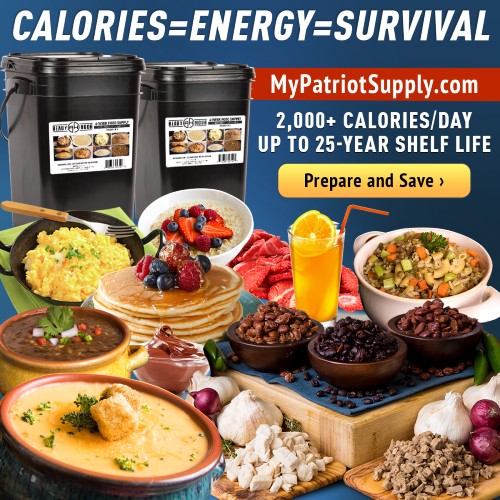- Watch The JD Rucker Show every day to be truly informed.
Editor’s Note: The author of this article placed Amazon affiliate links throughout. This benefits her directly when you make purchases. I’m okay with that because she allows us to republish her informative articles free of charge, so we happily defer any revenue she makes from it.
(The Organic Prepper)—Do you keep manual kitchen tools on hand so that you can cook from scratch, even when the lights go out? Every prepper’s kitchen could potentially benefit from these items. Some of them are like the ones our great-grandmothers used, while others are more closely related to a manual version of modern items.
Here is a list of kitchen tools that you may want to add. I use several of these right now and have for years.
Chopper
I have this manual food chopper and use it regularly. It makes fast work of things like onions, garlic, and other veggies and saves me so much time during canning season. I also use it when I need a lot of a particular chopped item, and when making fresh salsa. It’s an inexpensive addition to your prepper kitchen that can save you a lot of time chopping, dicing, and mincing.
Slicer
A good quality mandoline like this one can be incredibly useful when you need to slice things uniformly and thinly. I use mine particularly when I’m dehydrating produce to get thin, even slices.
Food mill
Canners will recognize a food mill. It helps you to get a nice, smooth puree for things like marinara or apple sauce. You can also use it for potatoes and even for baby food if you have a tiny human in the house. I find a food mill to be invaluable. I love this one because it’s ergonomic and easy to use.
Rotary beater
I still have and use my granny’s rotary beater. The listing calls this item an egg beater but it works well for baking too. Any place you’d use a handheld mixer, you can also use a rotary beater. You’ll have to put some muscle behind it but this will help with batters, frostings, and mixing. Sure, you can use a fork but I find that a beater incorporates my ingredients much better.
Mortar and pestle
I find a mortar and pestle to be invaluable. It’s a great tool for macerating herbs and also for grinding dried ones. This has both culinary and medicinal uses – I use it when getting herbs ready for a decoction or an infusion, and also for getting the most flavor out of my kitchen spices before adding them to a dish. I’ve also used it to grind up medication to hide in my pets’ food, and you could do the same for humans who perhaps cannot swallow a pill. This is a really nice one that is a useful size.
Can opener
Do you have a manual can opener? Do you have two? (One is none and two is one!) This one is very high quality and is also easy to use. I’ve had a few that were really difficult to crank, but the Gorilla Grip is my absolute favorite. This is a place you really don’t want to cheap out, particularly since preppers often rely heavily on commercially canned goods.
Manual meat grinder
Here’s another place you don’t want to cheap out: with a meat grinder. A meat grinder is a great way to make a tough, unpleasant cut of meat more palatable. I’ve tried the cheap $30-40 dollar ones and they break quickly, do a poor job, and are difficult to crank. This is the one that I swear by. It’s easy to assemble and disassemble for cleaning and works extremely well. Yes, it’s a bit of a physical workout, but not nearly as much as the cheap versions.
French press or pour-over coffee maker
If you want to be able to have your morning java long after the power goes out, there are two really simple options that only require your coffee and boiling water: the French press and the pour-over coffee maker. I’ve had this French press for years and always used it as my backup. But recently, my daughter got this pour-over coffee maker with a permanent filter. (I guess pour-over is trendy now?)
Both of these make a great cup of coffee, and really, it’s up to your personal preference what kind to get. French press is less filtered and makes a stronger, bolder cup of coffee, so if you prefer a blonde roast or a lighter cup, you’ll want the pour-over version. If you get your coffee in whole-bean form, you’ll also want a coffee grinder. I love the vintage look of this one: the reviews are great and the price is right.
Pasta maker
Do you like pasta? Do you have hundreds of pounds of wheat put aside? If the answer to these questions is yes, then you might benefit from a manual pasta maker. It’ll save you a lot of effort when you can run your dough through this instead of rolling it out and carefully slicing it to the right size. Not only does it work well for noodles, but you can also use it for making dumplings and pierogie.
Tortilla press
I got my cast iron tortilla press in Mexico, but this one is very, very similar. It’s the very best way to get a nice thin tortilla to fry up. It’s nearly impossible to roll the dough thin enough, and that’s extremely time-consuming. Tortillas are another great way to use your stash of grains, and they are quick to make with a press. Ladies who I knew when I lived in Mexico would spend a few hours every weekend making fresh tortillas for the week ahead. Once you’ve had homemade tortillas, you’ll never want to go back to storebought.
Wheat mill
Grinding wheat is hard work. In good times, I would always recommend using an electric wheat grinder because the job is time-consuming and takes a lot of muscle. But if the power is out and you want to work your way through those wheatberries, you need a proper grinder.
I’ve tried numerous different brands, and I always go back to the Wondermill Junior. There’s no other grinder around that does such a good job and really does so as efficiently as possible. Yes, there are cheaper ones, but you get what you pay for. If you stash grains in their whole form, you will need a grinder to make them ready for cooking. You can grind basically any grain with this device, and it also includes an auger to make masa and nut butter.
If the Wondermill is too spendy, this is the next best choice.
What are some manual kitchen tools you recommend?
Do you have manual tools for your kitchen? Do you have the ones listed here? Are there others you’d recommend? And do you use them now or are you saving them for power outage situations?
- Concerned about your life’s savings as the multiple challenges decimate retirement accounts? You’re not alone. Find out how Genesis Precious Metals can help you secure your wealth with a proper self-directed IRA backed by physical precious metals.
Leave your thoughts about this article on Late Prepper Substack.
About Daisy
Daisy Luther is a coffee-swigging, adventure-seeking, globe-trotting blogger. She is the founder and publisher of three websites. 1) The Organic Prepper, which is about current events, preparedness, self-reliance, and the pursuit of liberty; 2) The Frugalite, a website with thrifty tips and solutions to help people get a handle on their personal finances without feeling deprived; and 3) PreppersDailyNews.com, an aggregate site where you can find links to all the most important news for those who wish to be prepared. Her work is widely republished across alternative media and she has appeared in many interviews.
Daisy is the best-selling author of 5 traditionally published books, 12 self-published books, and runs a small digital publishing company with PDF guides, printables, and courses at SelfRelianceand Survival.com You can find her on Facebook, Pinterest, Gab, MeWe, Parler, Instagram, and Twitter.
Five Things New “Preppers” Forget When Getting Ready for Bad Times Ahead
The preparedness community is growing faster than it has in decades. Even during peak times such as Y2K, the economic downturn of 2008, and Covid, the vast majority of Americans made sure they had plenty of toilet paper but didn’t really stockpile anything else.
Things have changed. There’s a growing anxiety in this presidential election year that has prompted more Americans to get prepared for crazy events in the future. Some of it is being driven by fearmongers, but there are valid concerns with the economy, food supply, pharmaceuticals, the energy grid, and mass rioting that have pushed average Americans into “prepper” mode.
There are degrees of preparedness. One does not have to be a full-blown “doomsday prepper” living off-grid in a secure Montana bunker in order to be ahead of the curve. In many ways, preparedness isn’t about being able to perfectly handle every conceivable situation. It’s about being less dependent on government for as long as possible. Those who have proper “preps” will not be waiting for FEMA to distribute emergency supplies to the desperate masses.
Below are five things people new to preparedness (and sometimes even those with experience) often forget as they get ready. All five are common sense notions that do not rely on doomsday in order to be useful. It may be nice to own a tank during the apocalypse but there’s not much you can do with it until things get really crazy. The recommendations below can have places in the lives of average Americans whether doomsday comes or not.
Note: The information provided by this publication or any related communications is for informational purposes only and should not be considered as financial advice. We do not provide personalized investment, financial, or legal advice.
Secured Wealth
Whether in the bank or held in a retirement account, most Americans feel that their life’s savings is relatively secure. At least they did until the last couple of years when de-banking, geopolitical turmoil, and the threat of Central Bank Digital Currencies reared their ugly heads.
It behooves Americans to diversify their holdings. If there’s a triggering event or series of events that cripple the financial systems or devalue the U.S. Dollar, wealth can evaporate quickly. To hedge against potential turmoil, many Americans are looking in two directions: Crypto and physical precious metals.
There are huge advantages to cryptocurrencies, but there are also inherent risks because “virtual” money can become challenging to spend. Add in the push by central banks and governments to regulate or even replace cryptocurrencies with their own versions they control and the risks amplify. There’s nothing wrong with cryptocurrencies today but things can change rapidly.
As for physical precious metals, many Americans pay cash to keep plenty on hand in their safe. Rolling over or transferring retirement accounts into self-directed IRAs is also a popular option, but there are caveats. It can often take weeks or even months to get the gold and silver shipped if the owner chooses to close their account. This is why Genesis Gold Group stands out. Their relationship with the depositories allows for rapid closure and shipping, often in less than 10 days from the time the account holder makes their move. This can come in handy if things appear to be heading south.
Lots of Potable Water
One of the biggest shocks that hit new preppers is understanding how much potable water they need in order to survive. Experts claim one gallon of water per person per day is necessary. Even the most conservative estimates put it at over half-a-gallon. That means that for a family of four, they’ll need around 120 gallons of water to survive for a month if the taps turn off and the stores empty out.
Being near a fresh water source, whether it’s a river, lake, or well, is a best practice among experienced preppers. It’s necessary to have a water filter as well, even if the taps are still working. Many refuse to drink tap water even when there is no emergency. Berkey was our previous favorite but they’re under attack from regulators so the Alexapure systems are solid replacements.
For those in the city or away from fresh water sources, storage is the best option. This can be challenging because proper water storage containers take up a lot of room and are difficult to move if the need arises. For “bug in” situations, having a larger container that stores hundreds or even thousands of gallons is better than stacking 1-5 gallon containers. Unfortunately, they won’t be easily transportable and they can cost a lot to install.
Water is critical. If chaos erupts and water infrastructure is compromised, having a large backup supply can be lifesaving.
Pharmaceuticals and Medical Supplies
There are multiple threats specific to the medical supply chain. With Chinese and Indian imports accounting for over 90% of pharmaceutical ingredients in the United States, deteriorating relations could make it impossible to get the medicines and antibiotics many of us need.
Stocking up many prescription medications can be hard. Doctors generally do not like to prescribe large batches of drugs even if they are shelf-stable for extended periods of time. It is a best practice to ask your doctor if they can prescribe a larger amount. Today, some are sympathetic to concerns about pharmacies running out or becoming inaccessible. Tell them your concerns. It’s worth a shot. The worst they can do is say no.
If your doctor is unwilling to help you stock up on medicines, then Jase Medical is a good alternative. Through telehealth, they can prescribe daily meds or antibiotics that are shipped to your door. As proponents of medical freedom, they empathize with those who want to have enough medical supplies on hand in case things go wrong.
Energy Sources
The vast majority of Americans are locked into the grid. This has proven to be a massive liability when the grid goes down. Unfortunately, there are no inexpensive remedies.
Those living off-grid had to either spend a lot of money or effort (or both) to get their alternative energy sources like solar set up. For those who do not want to go so far, it’s still a best practice to have backup power sources. Diesel generators and portable solar panels are the two most popular, and while they’re not inexpensive they are not out of reach of most Americans who are concerned about being without power for extended periods of time.
Natural gas is another necessity for many, but that’s far more challenging to replace. Having alternatives for heating and cooking that can be powered if gas and electric grids go down is important. Have a backup for items that require power such as manual can openers. If you’re stuck eating canned foods for a while and all you have is an electric opener, you’ll have problems.
Don’t Forget the Protein
When most think about “prepping,” they think about their food supply. More Americans are turning to gardening and homesteading as ways to produce their own food. Others are working with local farmers and ranchers to purchase directly from the sources. This is a good idea whether doomsday comes or not, but it’s particularly important if the food supply chain is broken.
Most grocery stores have about one to two weeks worth of food, as do most American households. Grocers rely heavily on truckers to receive their ongoing shipments. In a crisis, the current process can fail. It behooves Americans for multiple reasons to localize their food purchases as much as possible.
Long-term storage is another popular option. Canned foods, MREs, and freeze dried meals are selling out quickly even as prices rise. But one component that is conspicuously absent in shelf-stable food is high-quality protein. Most survival food companies offer low quality “protein buckets” or cans of meat, but they are often barely edible.
Prepper All-Naturals offers premium cuts of steak that have been cooked sous vide and freeze dried to give them a 25-year shelf life. They offer Ribeye, NY Strip, and Tenderloin among others.
Having buckets of beans and rice is a good start, but keeping a solid supply of high-quality protein isn’t just healthier. It can help a family maintain normalcy through crises.
Prepare Without Fear
With all the challenges we face as Americans today, it can be emotionally draining. Citizens are scared and there’s nothing irrational about their concerns. Being prepared and making lifestyle changes to secure necessities can go a long way toward overcoming the fears that plague us. We should hope and pray for the best but prepare for the worst. And if the worst does come, then knowing we did what we could to be ready for it will help us face those challenges with confidence.








